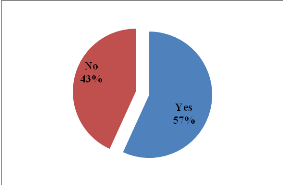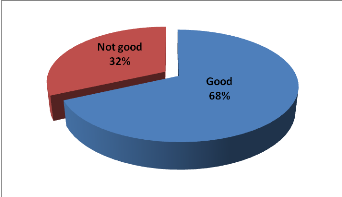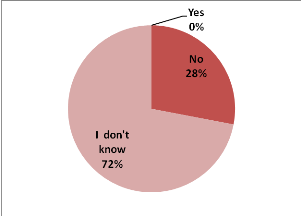Chart 4.1.13 Use of
protective equipment

Source: Field research, June 2011
According to safety standards, the exterior of construction
sites shall be barricaded with construction fencing, chain link fencing or
warning tape. Inside, signs shall be posted conspicuously particularly on
restricted areas. Also, there should be signs indicating the kind of PPE to
wear when entering specific areas. Amongst the most common PPE needed when
entering construction sites are, hard hats, safety glasses, long trousers,
safety vest, and steel toe boots. These PPE should be worn at all times when
inside the construction area. When the working elevation is high, the
appropriate fall protection gear should be used.
It should be recalled to all technicians that the use of PPE
will eventually help them. It saves life. A construction worker utilizing
complete PPE will be greatly shielded against common mishaps that happen in
their workplace. It can also lessen the risks of serious injury or even death.
That is why the company should avail adequate PPE, train all employees on how
they are used and when and make it the use of PPE a policy among other policies
governing the company.
Table 4. 1.14 Status of
personal protective equipment
|
Status
|
Number
|
Percentage
|
|
Good
|
30
|
68.18
|
|
Not good
|
14
|
31.82
|
|
Total
|
44
|
100
|
Source: Field research, June 2011
The table and chart 4.1.14 illustrate the status of protective
equipments. 30 respondents or 68% were in good status while 32% were not
good.
Figure 4.1.14 Status of
personal protective equipment

Source: Field research, June 2011
This is a threat to employees using defective PPE which means
they are exposed to injuries at work. That is why the company should provide
suitable PPE to all employees and set a policy which states clearly on that
with clear responsibilities to technicians such as to attend and comply with
training, instruction and information, to check the condition of their PPE , to
store, clean and maintain their PPE and to report losses, defects or other
problems with PPE and to their supervisorsupervisors such as to ensure adequate
information and training is provided to those who require PPE, to ensure that
PPE is properly stored, maintained, cleaned, repaired and replaced when
necessary because without proper maintenance, protective equipment will not be
able to offer the same level of protection.
Table 4.1.15 Existence of
Risk Management plans
|
Number
|
Percentage
|
|
Yes
|
0
|
0
|
|
No
|
14
|
28
|
|
Don't know
|
36
|
72
|
|
Sub Total
|
50
|
100
|
Source: Field research, June 2011
The table and chart 4.1.15 show that 72% of respondents do not
know whether there are risk management plans in the company, 28% knows that
there not while no one cofirmed their existence.
Chart 4.1.15 Existence of
Risk Management plans

Source: Field research, June 2011
It shows that there is a gap in communication which is too bad
to the company. However, it is abvious that there are no risk management plans
in the company, which is a big handicap for its management. RMP should be
present and functional in order to avoid preventable destructive risks and
enjoy benefits like to provide an assurance that the company/organization has
identified its highest-risk exposures and has taken steps to properly manage
these. To ensure that the company/organisation's business planning processes
include a focus on areas where risk management is needed and to establish a
process across the organisation that will integrate the various risk control
measures that the Organisation already has.
Table 4.1.16 Knowledge on
whether the company has internal rules and regulations
|
Number
|
Percentage
|
|
Yes
|
35
|
70
|
|
No
|
0
|
0
|
|
Don't know
|
15
|
30
|
|
Sub Total
|
50
|
100
|
Source: Field research, June 2011
The table and graph 4.1.16 indicate that 70% of respondents
know the existence of internal rules and regulations within the company while
30% do not know, no one denied their existence. It indicates that there is
still a problem with internal communication whereby every employee should get
oriented and read carefully internal rules and regulations of the company.
These spell out in simple and concrete terms the standards of professional
ethics applying to company staff members. These standards are to be regarded as
the professional values and culture the Organisation wants to promote and
uphold. They help employees to get information on their rights and what
they are supposed to provide for the employer.
| 


